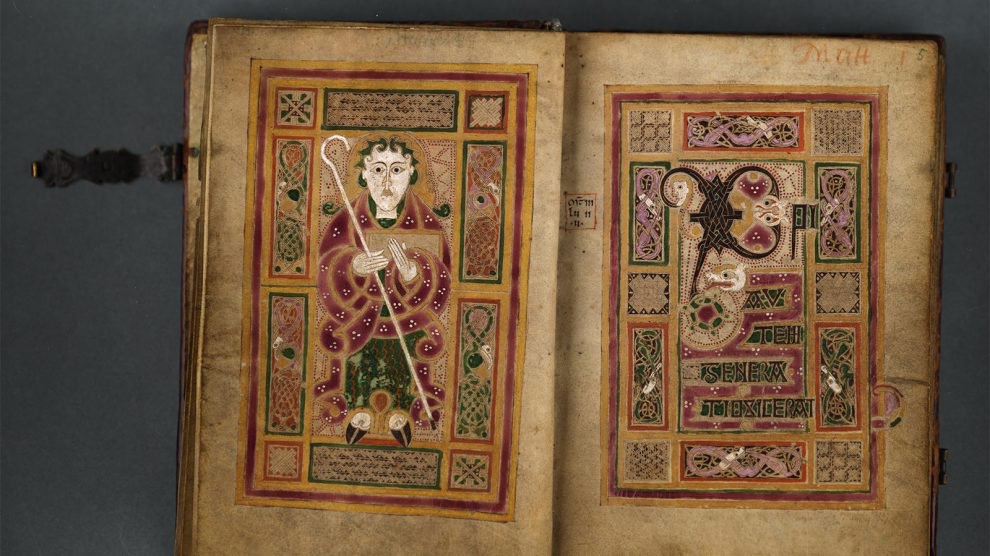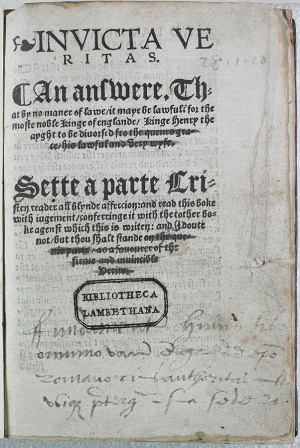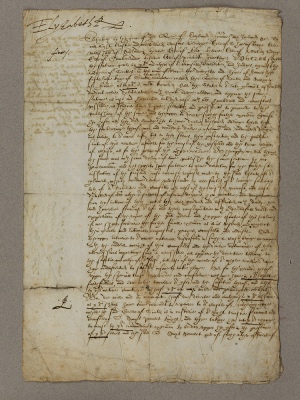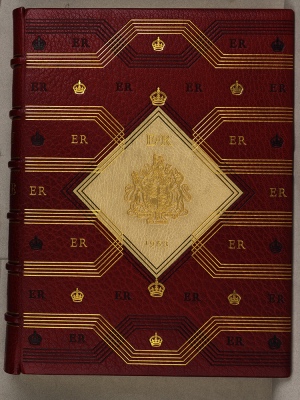London
RNS

The Mac Durnan Gospels, late ninth century, showing the opening of St Matthew’s Gospel. PICTURE: Courtesy of Lambeth Palace Library.
Work has begun on a new library to house the biggest collection of religious works in the world, outside the Vatican.
The library tower, due to open in two years, is the first edifice in 100 years to be built on the grounds of Lambeth Palace, home of the Archbishop of Canterbury, the head of the Church of England and the global Anglican Communion.

‘Invicta veritas’, published by Thomas Abel, chaplain to Catherine of Aragon, on the unlawfulness of her divorce, in 1532. This copy was owned by Henry VIII and annotated by him on the title page: “Fundament[um] huius libri omnino vanum” (“the grounds of this book are wholly worthless”). PICTURE: Courtesy of Lambeth Palace Library.
It will house major collections connected to the history of the Church of England and the Anglican Communion, the archives of the archbishops of Canterbury, records of Anglican clergy, genealogical sources, documents about the coronations of English monarchs and considerable numbers of manuscripts relating to Henry VIII, Elizabeth I, Mary Tudor and Mary Queen of Scots. The new building will also house the archives of the Church of England, known as the National Church Archives.
The nine-story structure, expected to cost £23 million, will also accommodate 120,000 books and 40,000 pamphlets that make up the existing Lambeth Palace Library collection, currently scattered across the palace. As some of the collection has started to deteriorate, the new building will be advanced in archiving and climate control and will be environmentally sustainable. Architects Wright & Wright have created an airtight, temperature-controlled “box within a box” to keep artifacts in the correct temperature and humidity conditions.
Although anyone can access the collection for free, the library is mainly used by more than 2,000 scholars, historians and ecclesiastical students every year from across the world. The new building will have extra space for the library to expand, as well as reading room facilities, conservation studios and staff workplaces and display space.
The Church Commissioners – the body that manages the Church of England’s property assets – have announced they will pay for the new building project, signaling how important the building will be in preserving the history of Anglicanism.

The only surviving copy of the warrant for the execution of Mary, Queen of Scots, in 1587, from the papers of Henry Grey, sixth Earl of Kent. PICTURE: Courtesy of Lambeth Palace library
The collection includes the execution warrant for Mary Queen of Scots by Elizabeth I in 1587 and illuminated gospels from the ninth century. Many manuscripts and documents that were held until the dissolution of the monasteries during the English Reformation are in the library.
The library has been on the same site as Lambeth Palace since it was founded in 1610, but the proximity of the site to the River Thames makes it at risk of flooding, which is why the architects designed a tower rather than a basement library.
“As well as historians who use the library, archbishops of Canterbury over the years have used documents from it, so we wanted to stay nearby for them,” said Declan Kelly, director of libraries.
Kelly said the library has also been useful in enhancing the visits of dignitaries to Lambeth. During a 2010 visit, for example, then-Pope Benedict XVI was shown documents belonging to Cardinal Pole, the last Catholic archbishop of Canterbury. African archbishops have frequently been shown materials that document the story of missionary work throughout modern-day Africa. American visitors, he said, were fascinated by an early Native American Bible written in the Iroquois language.
Among Kelly’s favorite historical documents in the library is a copy of Invicta Veritas, written by Thomas Abel, chaplain to Catherine of Aragon, about the indissolubility of marriage, with annotations in its margins by Henry VIII denouncing the argument. There are also letters between Albert Duke of York, later George VI, and the archbishop of Canterbury about the duke’s marriage to the future Queen Elizabeth, as well as many documents about the Anglican Communion’s relations with the Vatican.

The Bible used at the coronation of Queen Elizabeth II by Archbishop Geoffrey Fisher, in 1953, with an elaborate binding by Sangorski and Sutcliffe. PICTURE: Courtesy of Lambeth Palace Library
According to Professor Diarmaid MacCulloch, who teaches church history at the University of Oxford, Lambeth Palace Library is a vital resource for historical research, but until now “it had a rather random infrastructure forced on the staff by circumstance.” The new library will be “much more appropriate to the needs of the librarians and archivists,” he said. MacCulloch has regularly used the library for his own research, including for his volume Reformation: Europe’s House Divided 1490-1700.
“For me, the star of the collections remains Archbishop (Thomas) Cranmer’s Register, a formidable volume that has never been put into print, but is the central document for studying the Tudor Reformation,” said MacCullough.
While the bulk of Lambeth’s precious artifacts are paper documents, one star item is not: the shell of a tortoise that belonged first to Archbishop William Laud, archbishop of Canterbury from 1633 until 1645, when he was beheaded during the English Civil War. The tortoise lived until 1753, when it was killed after being struck by a gardener’s spade.
“Lambeth Palace Library has always been a public library,” said Kelly. “We remain very committed to this with our new building.”






